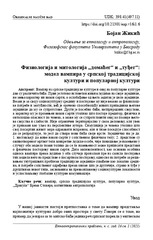Приказ основних података о документу
The Physiology and Mythology of the "Domestic" and the "Alien": The Model of the Vampire in Serbian Traditional Culture and Popular Culture
| dc.creator | Žikić, Bojan | |
| dc.date.accessioned | 2021-10-12T13:34:25Z | |
| dc.date.available | 2021-10-12T13:34:25Z | |
| dc.date.issued | 2021 | |
| dc.identifier.issn | 0353-1589 | |
| dc.identifier.uri | http://reff.f.bg.ac.rs/handle/123456789/3353 | |
| dc.description.abstract | The vampire in Serbian traditional culture and the vampire in popular culture are two different beings. The former is virtually identical to people in his community, does not undergo a change of character after death, and getting rid of him is the task of the whole community. He is linked to his socio-cultural environment and his existence is not linked to physiological needs and possibilities, but is circumscribed by the ability of the living members of his community to oppose him. The latter is a distinct being with supernatural abilities, whose character changes after death in the sense that he becomes a predator, a physical and ontological threat to man, and can be opposed by those who know his characteristics and weaknesses. He is not territorially restricted in his actions, but from the author's point of view he is always depicted as an interloper. He is a simulation of man insofar as he has to sustain himself in the afterlife by feeding himself, and has the ability to reproduce, i.e. to produce new beings of his kind. They have the following in common: 1) they continue to exist after death in their own physical body; 2) they are representations of the revived dead body of a concrete person, whose behavior has in the case of both models been altered precisely to the extent that this alteration can be ascribed to the notion of physical existence after death. The given malevolence, as the fundamental characteristic of the vampire's relationship to people, in both cases stems more from the meaning of the existence of these models than from a concept of an afterlife, that is, from the need to resolve the internal problems of the traditional community conceived as the local environment, and the need for self-determination towards that which is different, alien and foreign in societies of the new type, based on transcending socio-cultural locality and establishing global cultural communication. | en |
| dc.publisher | Univerzitet u Beogradu - Filozofski fakultet - Odeljenje za etnologiju i antropologiju, Beograd | |
| dc.rights | openAccess | |
| dc.rights.uri | https://creativecommons.org/licenses/by/4.0/ | |
| dc.source | Etnoantropološki problemi | |
| dc.subject | vampire | en |
| dc.subject | Serbian traditional culture | en |
| dc.subject | popular culture | en |
| dc.subject | cognitive anthropology | en |
| dc.subject | Bram Stoker's Dracula | en |
| dc.title | The Physiology and Mythology of the "Domestic" and the "Alien": The Model of the Vampire in Serbian Traditional Culture and Popular Culture | en |
| dc.type | article | |
| dc.rights.license | BY | |
| dc.citation.epage | 178 | |
| dc.citation.issue | 1 | |
| dc.citation.other | 16(1): 155-178 | |
| dc.citation.rank | M24~ | |
| dc.citation.spage | 155 | |
| dc.citation.volume | 16 | |
| dc.identifier.doi | 10.21301/eap.v16i1.6 | |
| dc.identifier.fulltext | http://reff.f.bg.ac.rs/bitstream/id/1918/3350.pdf | |
| dc.identifier.wos | 000641561700006 | |
| dc.type.version | publishedVersion |

